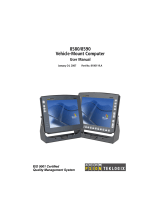
- 2 -
Overview
The UC-8580 Series computer is a programmable communication-centric
gateway offering a rich variety of communication interfaces, such as
Ethernet, serial, and digital inputs/outputs. This EN 50155-compliant
computer is built for rail applications and comes with multiple wireless
WAN gateway interfaces, making it an ideal choice for building wireless
communication infrastructure with 802.11 a/b/g/n/ac and for LTE data
collection and transmission.
Model Names and Package Checklist
The UC-8580 Series consists of the following models:
Coating
SMA
-25 to 55°C (-13 to 131°F)
-40 to 70°C (-40 to 158°F)
-40 to 70°C (-40 to 158°F)
QMA
-25 to 55°C (-13 to 131°F)
-40 to 70°C (-40 to 158°F)
-40 to 70°C (-40 to 158°F)
The UC-8580 Series computer is shipped with the following items:
• UC-8580 Series computer
• CBL-4PINDB9F-100: 4-pin pin header to DB9 female console port
cable, 100 cm
• Quick installation guide (printed)
• Warranty card
Appearance
The UC-8580 comes in two different front-panel models to support the
two different types of antenna connectors (SMA and QMA) for wireless
modules. The GPS antenna connector is secured to the front panel by
default. The SMA model uses the SMA connector for all antennas while the
QMA model uses a TNC connector for the GPS antenna and QMA
connectors for all other antennas.












